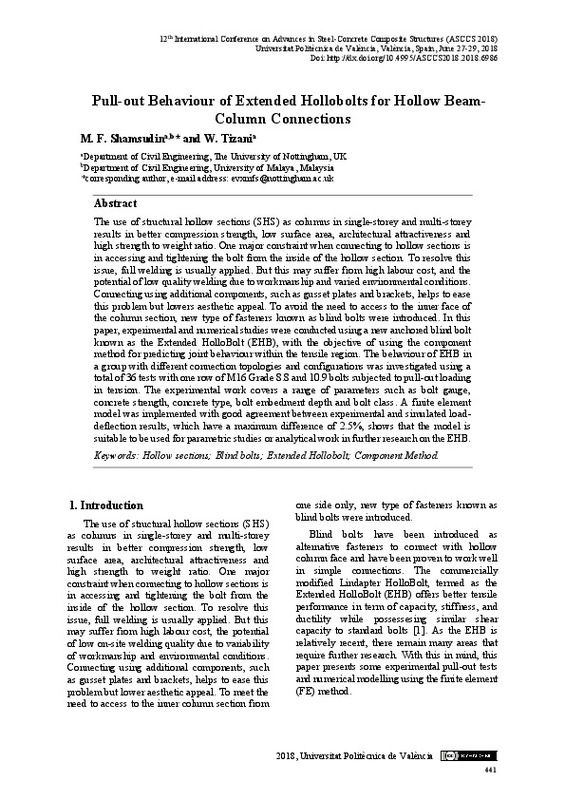JavaScript is disabled for your browser. Some features of this site may not work without it.
Buscar en RiuNet
Listar
Mi cuenta
Estadísticas
Ayuda RiuNet
Admin. UPV
Pull-out Behaviour of Extended Hollobolts for Hollow Beam-Column Connections
Mostrar el registro sencillo del ítem
Ficheros en el ítem
| dc.contributor.author | Bin Shamsudin, Mohd Fazaulnizam
|
es_ES |
| dc.contributor.author | Tizani, Walid
|
es_ES |
| dc.date.accessioned | 2018-10-10T06:49:03Z | |
| dc.date.available | 2018-10-10T06:49:03Z | |
| dc.date.issued | 2018-06-05 | |
| dc.identifier.isbn | 9788490486016 | |
| dc.identifier.uri | http://hdl.handle.net/10251/109984 | |
| dc.description.abstract | [EN] The use of structural hollow sections (SHS) as columns in single-storey and multi-storey results in better compression strength, low surface area, architectural attractiveness and high strength to weight ratio. One major constraint when connecting to hollow sections is in accessing and tightening the bolt from the inside of the hollow section. To resolve this issue, full welding is usually applied. But this may suffer from high labour cost, and the potential of low quality welding due to workmanship and varied environmental conditions. Connecting using additional components, such as gusset plates and brackets, helps to ease this problem but lowers aesthetic appeal. To avoid the need to access to the inner face of the column section, new type of fasteners known as blind bolts were introduced. In this paper, experimental and numerical studies were conducted using a new anchored blind bolt known as the Extended HolloBolt (EHB), with the objective of using the component method for predicting joint behaviour within the tensile region. The behaviour of EHB in a group with different connection topologies and configurations was investigated using a total of 36 tests with one row of M16 Grade 8.8 and 10.9 bolts subjected to pull-out loading in tension. The experimental work covers a range of parameters such as bolt gauge, concrete strength, concrete type, bolt embedment depth and bolt class. A finite element model was implemented with good agreement between experimental and simulated load-deflection results, which have a maximum difference of 2.5%, shows that the model is suitable to be used for parametric studies or analytical work in further research on the EHB. | es_ES |
| dc.format.extent | 8 | es_ES |
| dc.language | Inglés | es_ES |
| dc.publisher | Editorial Universitat Politècnica de València | es_ES |
| dc.relation.ispartof | Proceedings of the 12th International Conference on Advances in Steel-Concrete Composite Structures. ASCCS 2018 | es_ES |
| dc.rights | Reconocimiento - No comercial - Sin obra derivada (by-nc-nd) | es_ES |
| dc.subject | Hollow sections | es_ES |
| dc.subject | Blind bolts | es_ES |
| dc.subject | Extended hollobolt | es_ES |
| dc.subject | Component method | es_ES |
| dc.title | Pull-out Behaviour of Extended Hollobolts for Hollow Beam-Column Connections | es_ES |
| dc.type | Capítulo de libro | es_ES |
| dc.type | Comunicación en congreso | es_ES |
| dc.identifier.doi | 10.4995/ASCCS2018.2018.6986 | |
| dc.rights.accessRights | Abierto | es_ES |
| dc.description.bibliographicCitation | Bin Shamsudin, MF.; Tizani, W. (2018). Pull-out Behaviour of Extended Hollobolts for Hollow Beam-Column Connections. En Proceedings of the 12th International Conference on Advances in Steel-Concrete Composite Structures. ASCCS 2018. Editorial Universitat Politècnica de València. 441-448. https://doi.org/10.4995/ASCCS2018.2018.6986 | es_ES |
| dc.description.accrualMethod | OCS | es_ES |
| dc.relation.conferencename | 12th international conference on ‘Advances in Steel-Concrete Composite Structures’ - ASCCS 2018 | es_ES |
| dc.relation.conferencedate | Junio 27-29,2018 | es_ES |
| dc.relation.conferenceplace | Valencia. Spain | es_ES |
| dc.relation.publisherversion | http://ocs.editorial.upv.es/index.php/ASCCS/ASCCS2018/paper/view/6986 | es_ES |
| dc.description.upvformatpinicio | 441 | es_ES |
| dc.description.upvformatpfin | 448 | es_ES |
| dc.type.version | info:eu-repo/semantics/publishedVersion | es_ES |
| dc.relation.pasarela | OCS\6986 | es_ES |








